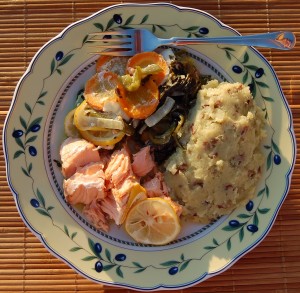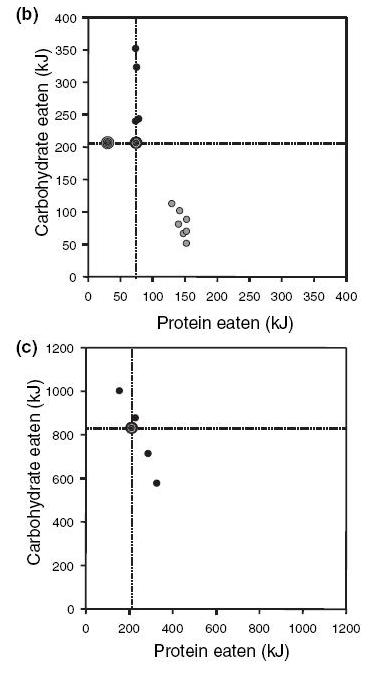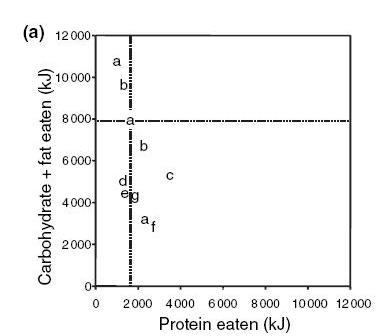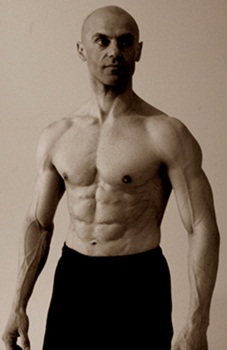At the very beginning of our book’s macronutrient discussion (p 8), we offer four reasons to believe in a macronutrient intake around 30% carb, 55% fat, 15% protein – a relatively low-carb diet by modern standards. (Note: these ratios were updated slightly in our 2012 edition.)
One of them is that hunter-gatherer populations ate approximately in these proportions. Our cite was a 2006 review paper by Loren Cordain [1] that was based on an earlier paper (by Cordain, Janette Brand-Miller, S. Boyd Eaton, and others) in the American Journal of Clinical Nutrition [2]. These papers estimated hunter-gatherer diets from data in JP Gray’s 1999 corrected version of the 1967 Ethnographic Atlas of GP Murdock. [3]
The Cordain et al paper in AJCN was accompanied by an editorial from Katherine Milton [4] and a series of letters. Milton argued [5] that the underlying data was unreliable. Chris Masterjohn summarized her point in his review of our book:
Katherine Milton has pointed out (here) that when “casual agriculturists” and hunters that hunt with modern guns are excluded, Cordain’s 229 “hunter-gatherers” are reduced to only 24. Although Milton often seems biased in favor of plant foods, I’m not sure how much “hunter-gatherers” hunting with modern guns can tell us about what humans were eating 40,000 years ago.
The Ethnographic Atlas was compiled from anthropological contacts early in the 20th century, long after first contact of these peoples with modern societies. The peoples involved had changed their lifestyles based on trade, acquiring guns and other tools as well as access to agricultural goods. Milton was concerned that these acquisitions may have distorted their diets. Milton was also concerned that the (largely male) anthropologists who collected the data may have neglected the activities of women, who gathered plant foods, in favor of men, who hunted.
Milton presented no data of her own. Clearly it would be desirable to have data acquired directly from hunter-gatherer tribes not using guns or agriculture, and from a source other than Cordain and Eaton, whose version of the Paleo diet looks suspiciously influenced by the lipid hypothesis.
Well, we’re in luck.
Miki Ben Dor of the Hebrew-language blog Paleostyle has written to tell me of an interesting 2000 paper [6] by anthropologists Hillard Kaplan, Kim Hill, Jane Lancaster, and Ana Magdalena Hurtado in the journal Evolutionary Anthropology. Hurtado and Hill later became collaborators on Cordain’s acne paper [7].
Miki discusses the paper in Hebrew here. (Miki, by the way, wrote a very nice review of our book here.) For the benefit of those who don’t read Hebrew, I thought I’d present the data.
The Data
The authors present data on diets from nine hunter-gatherer cultures. The essentials are in this table (click to enlarge):
Seeds and nuts are significant only for the !Kung, who ate mongongo nuts, which provide primarily fat calories.
Fruit was a large source of calories only for the Nukak, Gwi, and Hadza. The “fruit” the Nukak of Colombia eat is the palm fruit, which has a small amount of starch but whose calories consist overwhelmingly of fat calories from palm oil. Palm oil is a healthy oil that is 50% saturated fat, 40% monounsaturated fat. The “fruit” the Hadza ate was also fatty, averaging 1200 calories/pound compared to 200 calories/pound for sweet fruits; sources included Baobab fruit and Kongoro berry. The Gwi San consumed melons, a sweet fruit.
Save for the Nukak and Hadza, the sum of root, fruit, and “other plant” intake is a fair approximation to total carb plus fiber calories. These added up to 242 calories/day for the Onge, 137 calories/day for the Anbarra, 469 calories/day for the Arnhem, 277 calories for the Ache, 386 for the Hiwi, 300 for the !Kung, and 1200 for the Gwi. In all cases except the Gwi, carb intake was less than 20% of calories.
For the Nukak, carb intake was probably also in this range. So seven of nine cultures ate 10% to 20% carbs; for the Gwi San a majority of calories were carbs, and for the Hadza perhaps 40% of calories were carbs.
Meanwhile, foods obtained by men – primarily meat – provided 70% to 85% of calories for the Onge, Anbarra, Arnhem, Ache and Hiwi; 60% for the Nukak, about 50% for the !Kung, and 65% for the Hadza. [Table 2]
Another interesting observation from this data is that fruits were generally a less important source of calories than roots. It is likely that starches have outweighed sugars as a source of calories for humans for at least the last 2 million years.
Conclusion
In the book we argued that most hunter-gatherer cultures, when they weren’t constrained by Malthusian population pressures and famines, probably ate close to a 20% carb, 65% fat, 15% protein macronutrient ratio.
This data is largely consistent with that. Indeed, most cultures seem to have eaten slightly less than 20% carbs.
This paper does not provide sufficient data to break down the protein vs fat composition of the diets. But since protein seems to be eaten to a specific target of around 15% of energy / 360 calories by nearly all observed cultures, we can guess that that’s how hunter-gatherers ate as well. The acquisition of fat calories from fatty fruits and nuts, like palm fruits, confirms that fat was sought after.
The preference for starchy roots and tubers over sugary fruits is also no surprise. Not only are roots and tubers more calorie rich than most fruits, they are also (given the problematic nature of fructose) probably the healthier choice!
We don’t idolize Paleolithic or modern hunter-gatherer diets, so I won’t say that this data by itself proves our diet is correct. But I think it does add to the evidence that ancestral humans ate a diet that closely resembles ours.
References
[1] Cordain, L. “Implications of Plio-Pleistocene Hominin Diets for Modern Humans,” pp 363-383 in Peter S. Ungar, ed., Evolution of the human diet: the known, the unknown, and the unknowable, New York: Oxford University Press, 2006. http://www.thepaleodiet.com/articles/2006_Oxford.pdf.
[2] Cordain L et al. Plant-animal subsistence ratios and macronutrient energy estimations in worldwide hunter-gatherer diets. Am J Clin Nutr. 2000 Mar;71(3):682-92. http://pmid.us/10702160.
[3] Gray JP. A corrected ethnographic atlas. World Cultures J 1999; 10:24–85. Murdock GP. Ethnographic atlas: a summary. Ethnology 1967; 6:109–236.
[4] Milton K. Hunter-gatherer diets—a different perspective. Am J Clin Nutr. 2000 Mar;71(3):665-7. http://pmid.us/10702155.
[5] Milton K. Reply to L. Cordain et al. Am J Clin Nutr 2000 Dec;72(6):1590-1592. http://www.ajcn.org/content/72/6/1590.full.
[6] Kaplan HS, Hill KR, Lancaster JB, Hurtado AM. A Theory of Human Life History Evolution: Diet, Intelligence, and Longevity. Evolutionary Anthropology 9:156-185, 2000. http://www.unm.edu/~hkaplan/KaplanHillLancasterHurtado_2000_LHEvolution.pdf.
[7] Cordain L et al. Acne vulgaris: a disease of Western civilization. Arch Dermatol. 2002 Dec;138(12):1584-90. http://pmid.us/12472346.
















Recent Comments